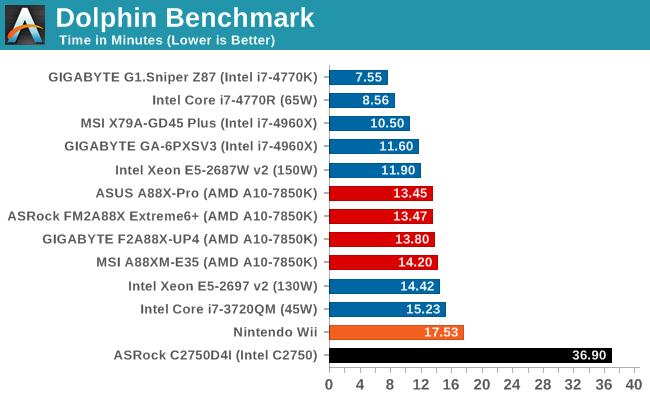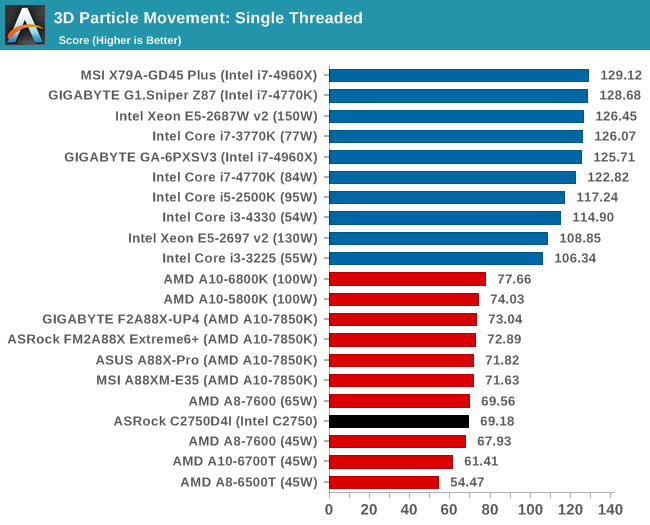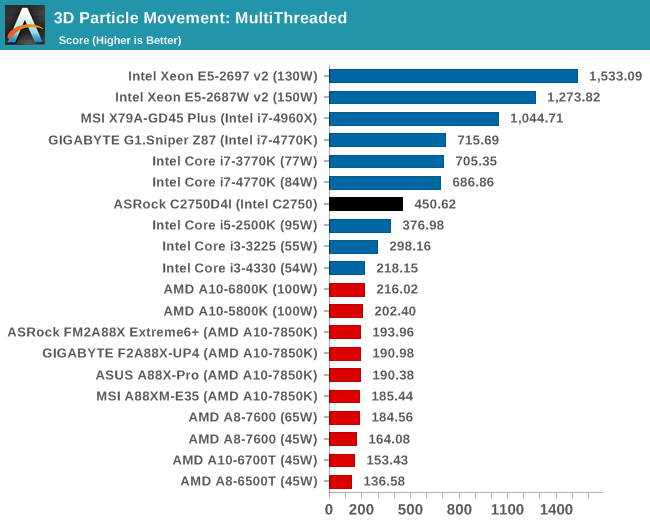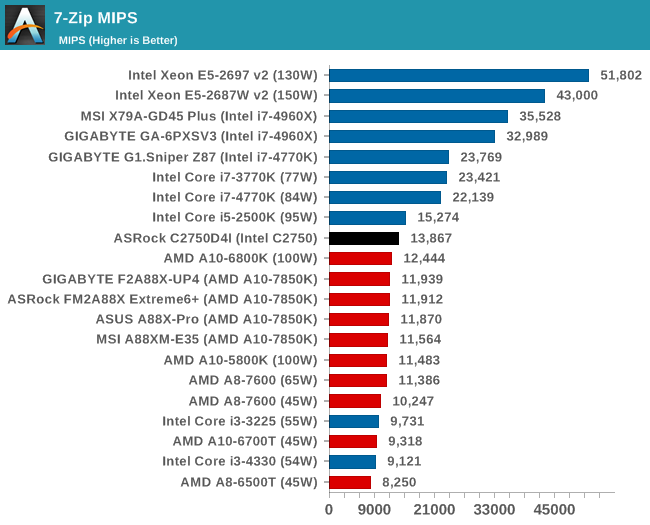ASRock Rack C2750D4I Review: A Storage Motherboard with Management
by Ian Cutress on April 29, 2014 9:00 AM EST- Posted in
- Motherboards
- Storage
- Atom
- ASRock
- Silvermont
- Enterprise
- server
- Avoton
Scientific and Synthetic Benchmarks
2D to 3D Rendering –Agisoft PhotoScan v1.0: link
Agisoft Photoscan creates 3D models from 2D images, a process which is very computationally expensive. The algorithm is split into four distinct phases, and different phases of the model reconstruction require either fast memory, fast IPC, more cores, or even OpenCL compute devices to hand. Agisoft supplied us with a special version of the software to script the process, where we take 50 images of a stately home and convert it into a medium quality model. This benchmark typically takes around 15-20 minutes on a high end PC on the CPU alone, with GPUs reducing the time.

Console Emulation –Dolphin Benchmark: link
At the start of 2014 I was emailed with a link to a new emulation benchmark based on the Dolphin Emulator. The issue with emulators tends to be two-fold: game licensing and raw CPU power required for the emulation. As a result, many emulators are often bound by single thread CPU performance, and general reports tended to suggest that Haswell provided a significant post to emulator performance. This benchmark runs a Wii program that raytraces a complex 3D scene inside the Dolphin Wii emulator. Performance on this benchmark is a good proxy of the speed of Dolphin CPU emulation, which is an intensive single core task using most aspects of a CPU. Results are given in minutes, where the Wii itself scores 17.53; meaning that anything above this is faster than an actual Wii for processing Wii code, albeit emulated.

Emulation is clearly not a target for Avoton.
Point Calculations – 3D Movement Algorithm Test: link
3DPM is a self-penned benchmark, taking basic 3D movement algorithms used in Brownian Motion simulations and testing them for speed. High floating point performance, MHz and IPC wins in the single thread version, whereas the multithread version has to handle the threads and loves more cores.


As the 3DPM test abuses the ability for a CPU to dispatch threads and FP calculations, Intel have historically been good here. The CPU battles with AMD in single threaded, but the 8 cores allows software to exploit parallelism in this manner.
Encryption –TrueCrypt v0.7.1a: link
TrueCrypt is an off the shelf open source encryption tool for files and folders. For our test we run the benchmark mode using a 1GB buffer and take the mean result from AES encryption.

For AES software encryption, the Avoton platform enjoys the 8 cores but suffers from a lack of hardware acceleration, putting it in the region of the AMD CPUs.
Synthetic – 7-Zip 9.2: link
As an open source compression tool, 7-Zip is a popular tool for making sets of files easier to handle and transfer. The software offers up its own benchmark, to which we report the result.











85 Comments
View All Comments
S.D.Leary - Tuesday, April 29, 2014 - link
Actually, for the SMB/Home version I was thinking more along the lines of keeping all the management, but dropping the TPM.Dropping BOTH extra SATA switches. (No real need for these on a home Media Server, and honestly for many/most SMB, four 6TB drives would be more than enough)
Updating USB to 3.1 status
A digital video output.
Dropping the COM port
Thunderbolt 2 for external expansion (that way a SMB that was growing could add a storage chassis if needed)
And for Silverstone, a chassis with similar capabilities to the DS380, but with the following changes...
Drop 3.5" support. Ideally 4 Hot Swap 2.5" external bays, and one or two internal 2.5" bays.
An option for a Slim Optical drive.
Preferably a horizontal orientation to fit into an A/V setting.
Support for double wide normal graphics cards. This would probably necessitate a riser and horizontal orientation of the card.
Ian! A question for you. Do you have something that could test real time transcoding of Audio and Video? Both with and without a GPU?
SDLeary
Computer Bottleneck - Tuesday, April 29, 2014 - link
I like the idea of the consumer version as well.Make mine a C2550 and no additional SATA controllers. (SOC has six native SATA).
LastQuark - Monday, May 5, 2014 - link
You're looking at the wrong board. Check Bay Trail solutions. It will be perfect for your needs.swizeus - Tuesday, April 29, 2014 - link
Interesting as how Anandtech includes gaming benchmark for a storage centric motherboard, and with a decent card, it still be able to cope. What can you expect from a 25W CPU thoughLastQuark - Monday, May 5, 2014 - link
+1. It was a gross oversight of what this board is intended for.-=Hulk=- - Tuesday, April 29, 2014 - link
1. All recent Atoms (including Avaton's) support hardware AES acceleration:http://ark.intel.com/products/77987
2. 43W idle for the 5350??? What the hell??? I think your values are totally wrong....
50W for the C2758??? Look at that test with a similar Supermicro Mini-ITX motherboard:
http://www.servethehome.com/intel-avoton-rangeley-...
Ian Cutress - Tuesday, April 29, 2014 - link
Values aren't wrong, but the PSU is inefficient. Those values are also a full system build. I have to keep the same power supply across reviews for meaningful comparisons on the same efficiency curve, which I mention in the blurb above the power readings. I also mention that due to that fact, it's more a qualitative comparison than a quantitative.DanNeely - Tuesday, April 29, 2014 - link
I understand why you're using the same PSU for all your tests. But for really small/low power systems I'd suggest adding a second power test with a much smaller PSU, similar to how the old cast thermal tests for small enclosures were often done with both a big high power GPU and a small lower power one. The 1250W monster would allow for direct comparison with high power gaming systems; a second number from a ~250W PSU would provide a second number that would be more inline with typical use.watersb - Tuesday, April 29, 2014 - link
Wow! Thanks for writing about this one! I build small-office storage servers, and this might be exactly what we need!watersb - Tuesday, April 29, 2014 - link
"Users have been reporting that in Linux and FreeBSD, high intensity read/write workloads cause the controller to reset and elements to any software array are lost."Hmm. Not good. I see this with Sil3132 controllers, too. The PCIe x8 slot would let me install a modest controller like the old Intel/LSI SASUCI8, but that push the system price back into SuperMicro territory.